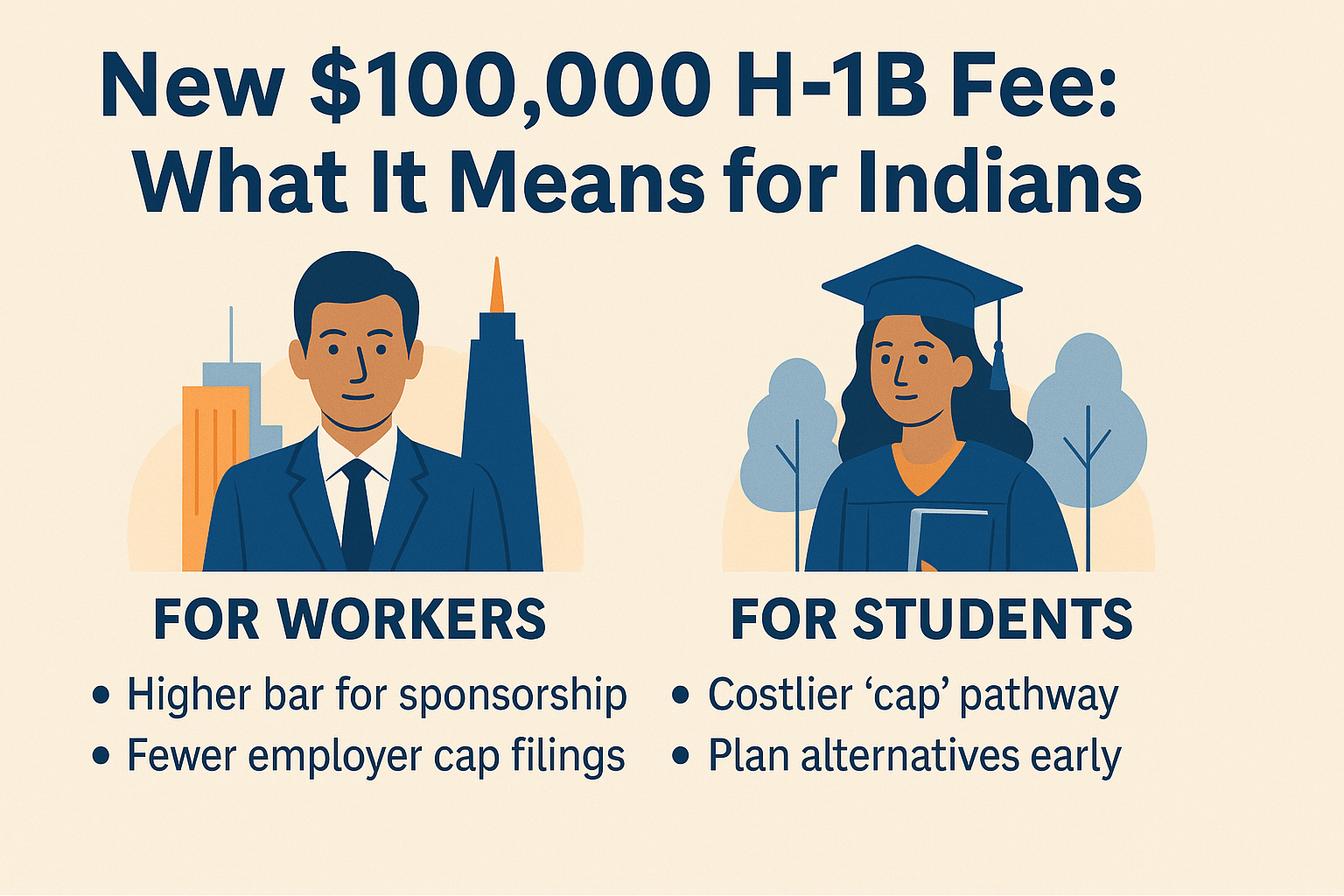Jasmine Grover Content Strategy Manager
Content Strategy Manager | Updated On - Sep 22, 2025
New Delhi, September 22, 2025 – The United States has introduced one of the most dramatic changes to its skilled work visa system in recent years. Under a new presidential proclamation titled “Restriction on Entry of Certain Nonimmigrant Workers”, employers must now pay a $100,000 one-time fee for every new H-1B petition filed on or after September 21, 2025.
The rule covers the 2026 H-1B lottery and any new filings after the effective date. While the White House says the change will curb abuse and protect American workers, Indians—who account for over 70% of H-1B holders—are expected to feel the sharpest impact.
Check Out
H1B Visa Fee Raised to $100,000
What exactly changed?
| Item | Before Sept 21, 2025 | From Sept 21, 2025 |
|---|---|---|
| Fee on new H-1B petitions | Standard filing fees only | One-time $100,000 fee must accompany every new petition |
| Applies to | — | New H-1B petitions (incl. 2026 lottery) |
| Does NOT apply to | — | Petitions filed before 12:01 a.m. EDT Sept 21, 2025; existing visas; travel by current holders; renewals |
| Agency actions | Usual processing | USCIS/CBP/DOS issued implementation guidance |
| Duration | — | Proclamation in force; further rulemaking on wages/lottery prioritization contemplated |
Important: The Proclamation states this is a one-time fee on submission of a new H-1B petition. It is not an annual fee.
Check Out: What is H1 Visa? How is it relevant for International Students?
Who among Indians is most affected?
Indians dominate the H-1B program, especially in STEM fields such as software engineering, data science, and consulting. The new cost barrier will hit three groups hardest:
- OPT graduates & early-career talent – Many Indian students finishing their U.S. Master’s or PhDs depend on the H-1B to stay back and work. A $100,000 price tag may make employers reluctant to sponsor entry-level roles.
- IT services & consulting employees – Outsourcing firms that file in bulk for junior engineers may scale down dramatically, reducing openings for Indian tech workers.
- India-based professionals seeking U.S. jobs – Those needing new petitions (cap-subject or otherwise) will see sponsorship opportunities shrink.
Meanwhile, existing H-1B holders and renewals remain unaffected. Your current visa is valid, and you can still travel in and out of the U.S. without paying the new fee.
Check Out: OPT for F1 Students
How will it change employer behavior?
The steep $100,000 barrier will likely reshape how U.S. firms approach Indian talent:
- Fewer filings overall – Many companies may not even reach the annual cap of 85,000 visas.
- Preference for senior roles – Employers will save sponsorships for critical, high-paying, or niche positions.
- Rise of alternatives – Expect more interest in O-1 (extraordinary ability) and EB-1A (priority worker) visas for top Indian professionals, as these bypass the lottery.
- Cautious transfers – Mid-career workers changing employers could struggle if a new petition is needed.
What it means for Indian students in USA? (OPT → H-1B path)
For Indian students on OPT (Optional Practical Training), this shift creates new uncertainty:
- H-1B filings become selective – Universities and employers may file fewer petitions, especially for entry-level roles.
- Stronger resumes matter – Those with higher salaries, patents, niche research, or leadership experience stand a better chance.
- Plan B is essential – Students should prepare backup options early, such as cap-exempt roles at universities or non-profits, or alternatives in Canada, the UK, or Ireland.
What stays the same?
According to the official guidance:
- No retroactivity – Applications filed before 12:01 a.m. EDT, Sept 21, 2025, are unaffected.
- Renewals/extensions – The new fee does not apply.
- Travel – Current H-1B holders can still travel internationally without penalty.
What’s coming next?
The proclamation also hints at further reforms:
- Prevailing wage increases – The U.S. Department of Labor may soon raise salary levels required for H-1B roles.
- Lottery reform – The Department of Homeland Security is exploring prioritizing higher-paid applicants instead of random draws.
- Additional changes – More restrictions could follow in the coming months.
Action plan for Indian professionals & students
If you’re a current H-1B holder
- Status/travel: No new fee; travel permitted as usual.
- Extensions/transfers: Confirm with counsel if your move requires a new petition (which could trigger the fee).
If you’re on OPT/CPT or graduating in 2026
- Strengthen your profile: Target higher salaries, niche skills, leadership, publications, open-source impact.
- Target cap-exempt employers: Universities/non-profits aren’t bound by the cap and often follow different rules.
- Evaluate alternatives: O-1/EB-1A, or non-U.S. destinations (Canada, UK, Ireland, UAE) if sponsorship stalls.
If you’re India-based seeking U.S. roles
- Expect fewer filings: Employers may limit new H-1Bs to mission-critical roles.
- Negotiate sponsorship terms: Clarify who bears costs; explore L-1 (intra-company) if eligible.
H1B Visa Fee Hike FAQs
Ques. Is the $100,000 fee annual?
Ans. No. Per the official FAQ you shared, it’s a one-time payment that must accompany a new H-1B petition filed on/after Sept 21, 2025.
Ques. Do renewals/extensions pay this fee?
Ans. No. The FAQ says renewals’ payments/fees do not change.
Ques. Does it affect current H-1B holders’ travel?
Ans. No. The Proclamation does not prevent travel for current H-1B holders.
Ques. Will the 2026 lottery be covered?
Ans. Yes. The FAQ explicitly says the 2026 lottery is included (new petitions filed after the effective time).



Comments